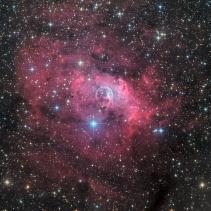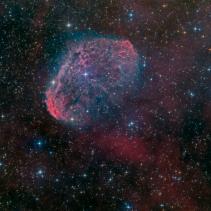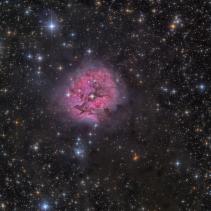Nebulas
NGC 7635
NGC 7635, also called the Bubble Nebula, Sharpless 162, or Caldwell 11, is a H II region emission nebula in the constellation Cassiopeia. It lies close to the direction of the open cluster Messier 52. The "bubble" is created by the stellar wind from a massive hot, 8.7 magnitude young central star, the 15 ± 5 M☉ SAO 20575 (BD+60 2522). The nebula is near a giant molecular cloud which contains the expansion of the bubble nebula while itself being excited by the hot central star, causing it to glow. It was discovered in 1787 by William Herschel. The star SAO 20575 or BD+602522 is thought to have a mass of 10-40 Solar masses.
L = 18 * 1200 sec. bin1, RGB = 9 * 900 sec. bin2, HaOIII = 10 * 1200 sec. bin2, in each filters.
Total exposition - 19.5 hours.
Amounts in the channels:
L - 1.7", RGB - 2.2", HaOIII - 2.1"
NGC 6888
The Crescent Nebula (also known as NGC 6888, Caldwell 27, Sharpless 105) is an emission nebula in the constellation Cygnus, about 5000 light-years away from Earth. It was discovered by Friedrich Wilhelm Herschel in 1792. It is formed by the fast stellar wind from the Wolf-Rayet star WR 136 (HD 192163) colliding with and energizing the slower moving wind ejected by the star when it became a red giant around 250,000 to 400,000[citation needed] years ago. The result of the collision is a shell and two shock waves, one moving outward and one moving inward. The inward moving shock wave heats the stellar wind to X-ray-emitting temperatures.
It is a rather faint object located about 2 degrees SW of Sadr. For most telescopes it requires a UHC or OIII filter to see. Under favorable circumstances a telescope as small as 8 cm (with filter) can see its nebulosity. Larger telescopes (20 cm or more) reveal the crescent or a Euro sign shape which makes some to call it the "Euro sign nebula".
L = 18 * 1200 sec. bin1, RGB = 9 * 900 sec. bin2, HaOIII = 10 * 1200 sec. bin2, n the each filters.
Total exposition - 19.5 hours
Pixinsight 1.8, Lightroom.
IC 5146
IC 5146 (also Caldwell 19, Sh 2-125, and the Cocoon Nebula) is a reflection/emission nebula and Caldwell object in the constellation Cygnus. The NGC description refers to IC 5146 as a cluster of 9.5 mag stars involved in a bright and dark nebula. The cluster is also known as Collinder 470. It shines at magnitude +10.0/+9.3/+7.2. Its celestial coordinates are RA 21h 53.5m, dec+47° 16′. It is located near the naked-eye star Pi Cygni, the open cluster NGC 7209 in Lacerta, and the bright open cluster M39. The cluster is about 4,000 ly away, and the central star that lights it formed about 100,000 years ago; the nebula is about 12 arcmins across, which is equivalent to a span of 15 light years. When viewing IC 5146, dark nebula Barnard 168 (B168) is an inseparable part of the experience, forming a dark lane that surrounds the cluster and projects westward forming the appearance of a trail behind the Cocoon.
L = 20 * 1200 sec. bin1, RGB = 13 * 900 sec. bin2, in the each filters.
Total exposition - 16.5 hours
Pixinsight 1.8, Lightroom.
M 27
The Dumbbell Nebula (also known as Apple Core Nebula, Messier 27, M 27, or NGC 6853) is a planetary nebula in the constellation Vulpecula, at a distance of about 1,360 light-years.
This object was the first planetary nebula to be discovered; by Charles Messier in 1764. At its brightness of visual magnitude 7.5 and its diameter of about 8 arcminutes, it is easily visible in binoculars, and a popular observing target in amateur telescopes.
The Dumbbell Nebula appears to be shaped like an prolate spheroid and is viewed from our perspective along the plane of its equator. In 1992, Moreno-Corral et al. computed that its rate of expansion in the plane of the sky was no more than 2.3" per century. From this, an upper limit to the age of 14,600 yr may be determined. In 1970, Bohuski, Smith, and Weedman found an expansion velocity of 31 km/s. Given its semi-minor axis radius of 1.01 ly, this implies that the kinematic age of the nebula is some 9,800 years.
L = 18 * 1200 sec. bin1, RGB = 10 * 1200 sec. bin2, HaOIII = 8 * 900 sec. bin2, n the each filters.
Total time - 20 hours
Pixinsight 1.8, Lightroom.




